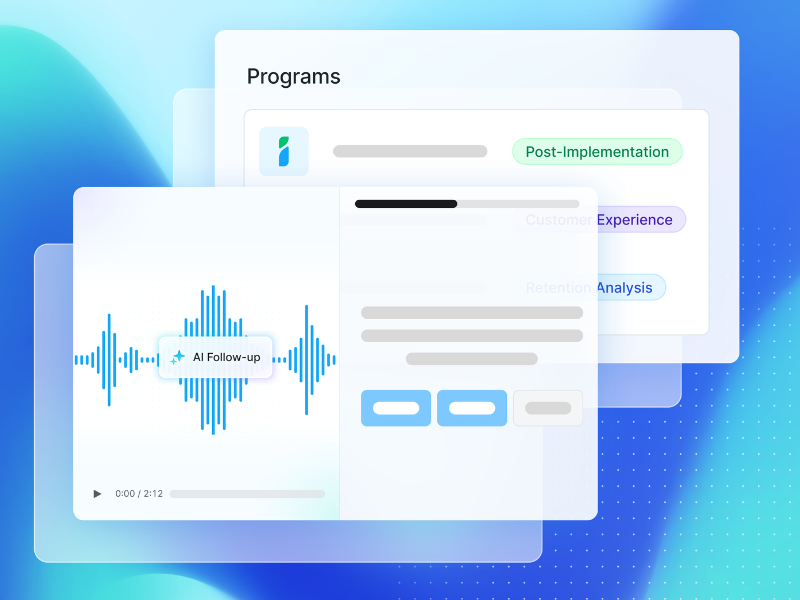
If you’ve ever received a survey invitation, it has probably been quite obvious which company, individual, or brand is asking for your feedback. But sometimes, a market research company may contact you on behalf of another organization “in the [insert industry here] industry,” without disclosing who is sponsoring the study.
Which kind of survey are you more likely to respond to? Would the nature of your feedback change at all?
In the context of win-loss interviews, a blind interview is one that is conducted by a consultant who does not disclose which company has hired them, or which company will see the feedback. A non-blind interview, on the other hand, does reveal who has paid for the research and will be receiving the feedback.
There are some obvious scenarios where blind (or even double- or triple-blind!) research is appropriate and necessary to reduce bias. Without blind experiments in clinical trials or social science, our world would look a lot different. But when it comes to win-loss analysis, what is the ideal methodology? As you might expect, our usual answer to this question is it depends. Depending on your goals and priorities, one will be better than the other.
So, to help you decide, let’s dive into some of the pros and cons:
Blind Interviews
In our experience, we’ve noticed a few things that blind interviews do well:
- The “30,000 Foot” View: A blind interview encourages the interviewee to focus on the big picture and provide high-level commentary about how they perceive the market as a whole, which requirements were important to them, and the direction they’d like the industry to move in the future.
- Competitive Insights: A blind interview encourages the interviewee to speak broadly about many competitors, rather than focusing specifically on what your company does well or poorly. You’ll get a bit of insight about all the different vendors they considered and what makes each unique at a very high-level.
- Battlecards: The high-level competitive insights can be useful for companies looking to develop competitive battlecards for sales enablement and training.
However, this “mile-wide, inch-deep” strategy has its shortcomings:
- Lack of Actionable Insight: A blind interview is more of an intellectual exercise, than an actionable one. To avoid revealing the sponsoring company, you’ll need to spend equal time on each competitor. That means the feedback will be relatively superficial. You’ll miss out on actionable insights that you would get if you probed deeply about your own company’s sales execution, its pricing strategy, the nuances of its product offering. Frankly, you might come away from a blind interview without having answered the pivotal question of “why did we win or lose this opportunity?”
- Lower Participation Rates: Why, as an interviewee, would you invest significant time and energy providing feedback to an “unknown” company? For this reason, participation rates in blind interviews are much lower. It also takes longer to get buyers to participate (more invitations) and often requires payment of a large incentive.
- Lack of Trust: Without understanding who is behind the research and what will be done with the feedback they are providing, interviewees tend to be skeptical. They may hold back critical information because of a lack of trust. They may be cautious about the feedback they share about each company because they aren’t sure who will use it and how.
Non-Blind Interviews
When there is transparency around who is sponsoring the study and what they plan to do with the feedback, the following happens:
- The conversation remains much more focused around the purchasing decision and the key drivers behind it.
- The interviewer probes into areas of concern for the business (marketing strategies, product capabilities, sales approaches, etc.) rather than keeping things superficial.
- The discussion around competitors remains more focused on the company’s relative position (were you seriously considered?) and relative strengths/weaknesses versus the primary competitor.
- More buyers are willing to participate - often doubling or tripling the overall participation rate. This saves you time and effort when developing your sample of deals to pursue.
- When there is more transparency between all parties, buyers tend to reciprocate and speak more openly - especially if they are speaking with a neutral, third-party.
The Clozd Approach
For these reasons, the predominant practice in the win-loss industry - and at Clozd - is to utilize a transparent, non-blind approach.
Clozd founder and chief methodologist, Spencer Dent, explains:
“When interviewees know who is behind the research, the feedback tends to be more practical and actionable. If there is transparency and they understand who they will be helping with their feedback, buyers participate at a higher rate and tend to be very forthright and honest in what they share. It also enables the interviewer to probe into key topics and areas that aren’t possible with a blind approach.”
Overall, the most important practice for minimizing bias and promoting candid feedback is to engage a neutral-third party like Clozd to conduct the interviews, allowing interviewees to feel safe in providing candid and open feedback.
For additional best practices and strategies, read our Definitive Guide to Win-Loss Analysis, available here.











.svg)





.png)



.svg)

.svg)




